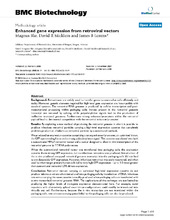Enhanced gene expression from retroviral vectors
Peer reviewed, Journal article
Permanent lenke
https://hdl.handle.net/1956/2695Utgivelsesdato
2008-02-25Metadata
Vis full innførselSamlinger
Originalversjon
https://doi.org/10.1186/1472-6750-8-19Sammendrag
Background: Retroviruses are widely used to transfer genes to mammalian cells efficiently and stably. However, genetic elements required for high-level gene expression are incompatible with standard systems. The retroviral RNA genome is produced by cellular transcription and posttranscriptional processing within packaging cells: Introns present in the retroviral genomic transcript are removed by splicing, while polyadenylation signals lead to the production of ineffective truncated genomes. Furthermore strong enhancer/promoters within the retroviral payload lead to detrimental competition with the retroviral enhancer/promoter. Results: By exploiting a new method of producing the retroviral genome in vitro it is possible to produce infectious retroviral particles carrying a high-level expression cassette that completely prohibits production of infectious retroviral particles by conventional methods. We produced an expression cassette comprising a strong enhancer/promoter, an optimised intron, the GFP open reading frame and a strong polyadenylation signal. This cassette was cloned into both a conventional MMLV retroviral vector and a vector designed to allow in vitro transcription of the retroviral genome by T7 RNA polymerase. When the conventional retroviral vector was transfected into packaging cells, the expression cassette drove strong GFP expression, but no infectious retrovirus was produced. Introduction of the in vitro produced uncapped retroviral genomic transcript into the packaging cells did not lead to any detectable GFP expression. However, infectious retrovirus was easily recovered, and when used to infect target primary human cells led to very high GFP expression – up to 3.5 times greater than conventional retroviral LTR-driven expression. Conclusion: Retroviral vectors carrying an optimized high-level expression cassette do not produce infectious virions when introduced into packaging cells by transfection of DNA. Infectious retrovirus carrying the same cassette is readily produced when packaging cells are transfected with in vitro transcribed retroviral genomic RNA. The applications of this technique are not limited to producing the higher levels of transgene expression demonstrated here. For example, novel reporters with alternatively spliced exon-intron configurations could readily be transduced into virtually any cell. Furthermore, because the in vitro transcripts are not translated within the packaging cells, retroviruses carrying genes lethal to the packaging cells can also be produced.
